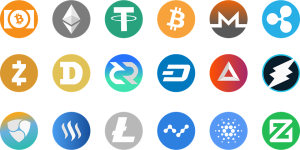Introduction
The word “altcoin” gained popularity after the launch of dozens of new Bitcoin alternatives in 2017. But in 2022, most of the top 100 cryptocurrencies aren’t even rivaled to Bitcoin. There are many new goods and applications on the market today, some of which differ significantly from others. It’s hard to keep track of everything in space with thousands of cryptocurrencies that are now in use. This article will showcase a few fascinating space advances to whet your appetite.

Ethereum
Without Ethereum, it isn’t easy to envisage the crypto industry. Most coins have been produced using Ethereum smart contracts since its launch in 2015. The term “smart contracts” is also misleading because neither smartness nor arrangements are required. The phrase “smart contract” refers to any blockchain-based program.
Superficial differences exist between Bitcoin and Ethereum: Ethereum is a ledger plus a computer, whereas Bitcoin is a ledger. Applications may be made by connecting a laptop to a blockchain (like new tokens, NFTs, lending markets, exchanges, and more).
Read Also: 17 profitable investment opportunities in Nigeria to make millions
To guarantee that every miner can maintain an accurate record without acquiring their own private data center, Ethereum’s computer has restricted storage space. This keeps the blockchain safe and decentralized, making it more difficult to gain control of it. The market places a great value on security, as seen by Ethereum’s hefty fees. The only factor used to determine the prices is the current availability and demand for space on Ethereum’s computer (blockchain). High costs are an indication of solid order rather than weakness. The problem is that many retail traders are priced out of Ethereum.
Some top initiatives tackling this will be on the list as the race to help Ethereum scale continues. Due to its better security, the Ethereum blockchain serves as the basis for and the location of most current blockchain activity. The Ether (ETH) native asset, which reflects the demand for the blockchain, powers the whole Ethereum network. You shouldn’t be shocked if Ether demand increases if Ethereum continues to offer the most significant security for high-value applications.
SushiSwap
Like Uniswap coin, SushiSwap is a blockchain-based exchange. SushiSwap started by copying and pasting the whole coding of Uniswap (which is public on the blockchain). Since then, SushiSwap has introduced several DeFi goods and services, which Uniswap has not (including loans, farming, and staking).
The development of SushiSwap and how it got to where it is now is a nearly fantastic tale. The original project’s founder vanished, taking millions of dollars with them. The SushiSwap community came together to transform the scam into a top-10 DeFi protocol with over $2 billion trapped in its smart contracts, refusing to let this be the tale’s end. A decentralized NFT platform is also being introduced, which many believe will be less problematic than OpenSea.
SushiSwap is a project to watch in 2022, even though there is still some controversy around its core staff (including a leader who just left on poor terms). The SEC is actively looking into Uniswap’s core staff, which poses a significant danger for its UNI coin. Although no studies specifically target SUSHI, this danger should not be ignored. Fortunately, the decentralization of Ethereum means that the SEC cannot thwart the operation of any exchange system.
Polygon
Polygon is one of the top cryptocurrencies for 2022, and Vitalik Buterin, the co-founder of Ethereum, supports it. As a layer-2 solution for Ethereum, Polygon uses the security and functionality of Ethereum on a different network that may be connected to your Ethereum wallet. Users may communicate with Ethereum apps via the MATIC Network without paying expensive transaction fees on Ethereum.
Several significant exchanges have already added support for integration with Polygon. For instance, Coinbase is planning to integrate Polygon, which is anticipated to launch in 2022. Low gas costs on the Polygon network have made it ideal for NFT transactions. Most NFTs were previously created on the Ethereum blockchain, but consumers seek more resilient networks as transaction costs increase. As a result of its layer two architecture, Polygon’s network makes trading NFTs substantially more affordable.
Web3 is meant to be scaled to the masses using Polygon and other layer-2 technologies. Users must pay fees ranging from $10 to over $100 during busy periods to utilize Ethereum’s blockchain. On the MATIC network of Polygon, users may use Ethereum for only cents. The integration of transactions to the MATIC network by Coinbase and other significant exchanges might increase the uptake of Polygon this year.
Stellar Lumens
Different, dispersed payment mechanisms are used by Stellar, a decentralized network for connecting the world’s numerous banking institutions (ACH, SEPA, SPIE, etc.). Through a decentralized ledger with on-off ramps for each payment mode, Stellar’s network links these systems.
The SEC is looking into Ripple, the closest rival to Stellar. The time is right for Stellar to seize the initiative and make a serious effort to establish itself as the world’s leading payment network.
Users must pay a transaction charge and fulfill a margin requirement in Lumens, the Stellar Network’s currency, to avoid spam (XLM).
Solana
The Solana blockchain for intelligent contracts has over $10 billion in locked-in protocols and a thriving DeFi ecosystem. Solana and other blockchains for smart contracts are viewed by many as “Ethereum-killers.” Others predict that when the market for blockchain goods expands, several of the most prominent blockchains for smart contracts will be able to operate at maximum capacity at once.
Regardless of the conclusion, the Solana blockchain will surely experience tremendous innovation because of its hefty VC funding. Sam Bankman Fried and the FTX team, who undoubtedly have the resources to assure the success of the blockchain, have embraced Solana.
Blockchain gaming and other applications make more sense on a high-throughput, low-fee chain like Solana. Still, many financial applications necessitate the security of a highly decentralized blockchain like Ethereum. SOL is the native token of Solana and is needed to communicate with the blockchain.